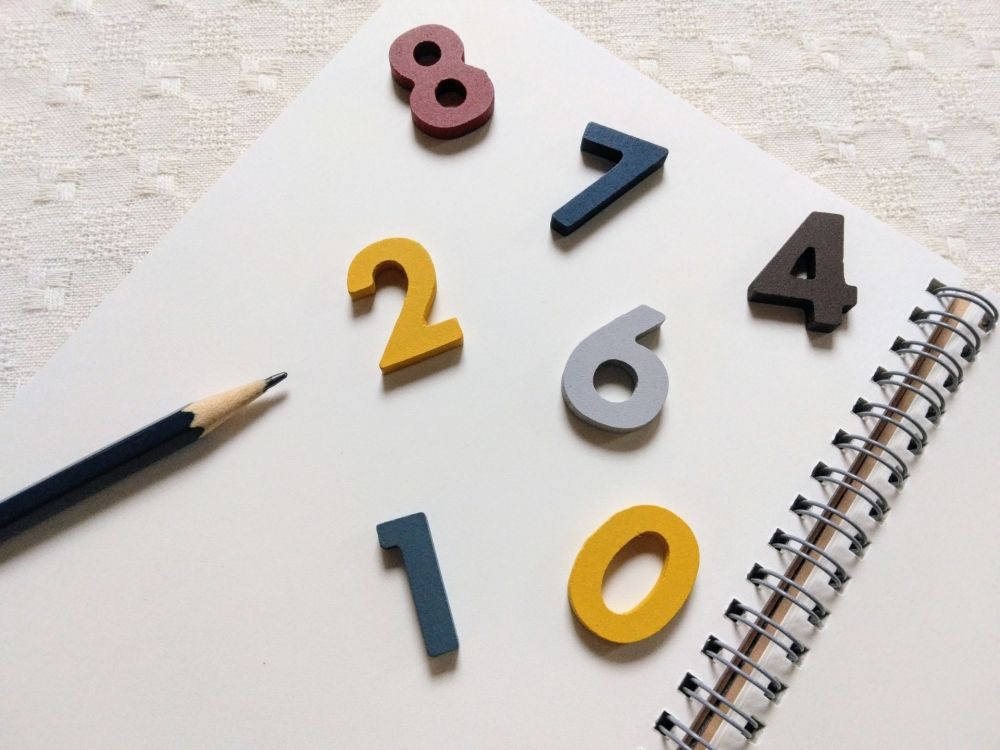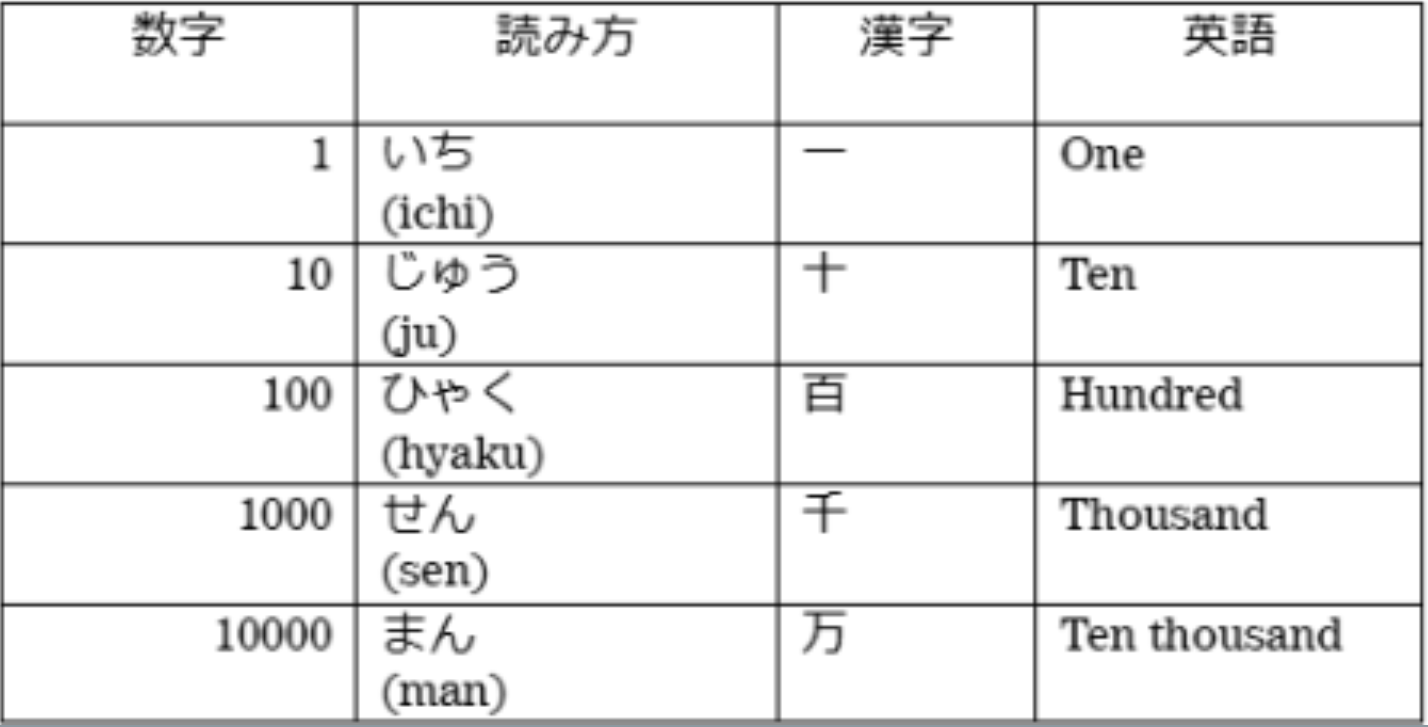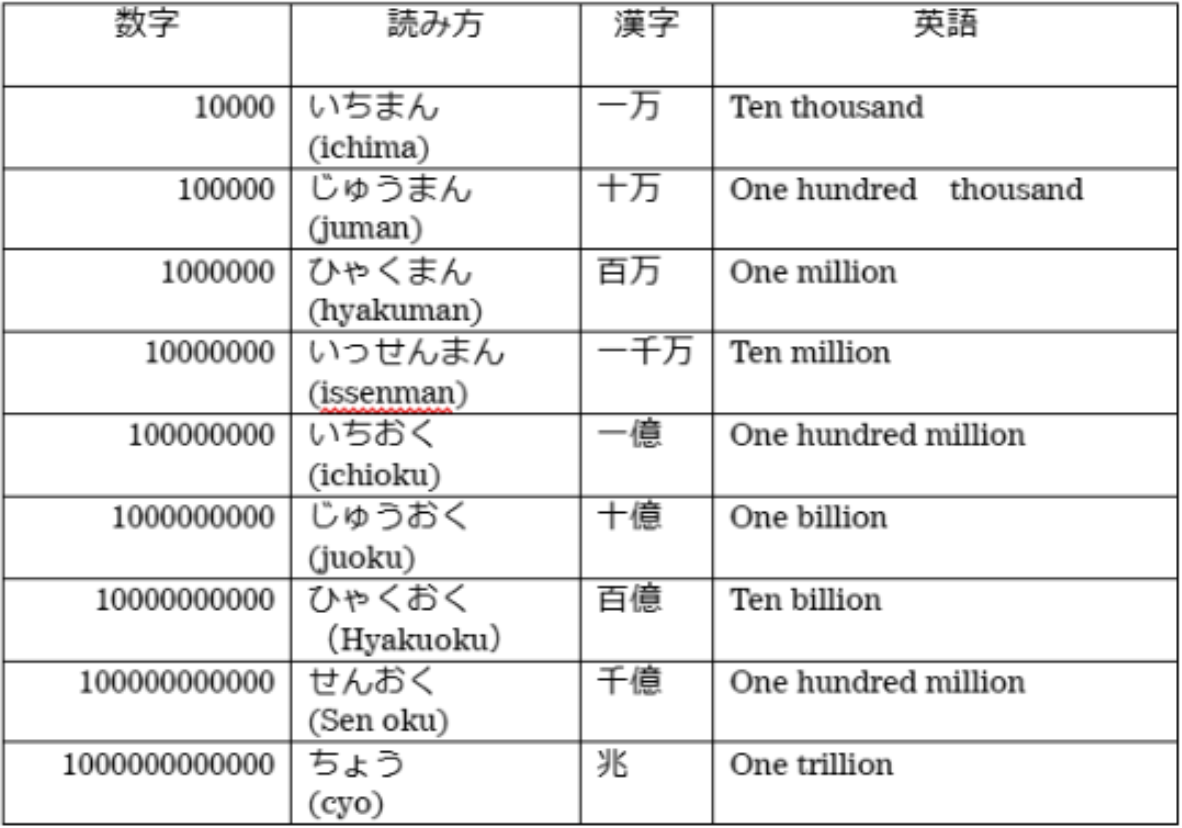

Exploring Japanese Number Units: Big and Small
“How do you say ‘ten thousand’ in Japanese?”
“My budget for a car is two million yen; how do I say that in Japanese?”
“How do you pronounce 0.12?”
“I’m not sure how to say 1/2.”
Number units and their readings can be tricky. Today, we’re introducing some that may seem familiar but are often surprisingly confusing.
Reading Numbers and Units
In Japanese, commonly used numbers include both Arabic numerals, which are used in many countries, and kanji characters for numbers.
Firstly, let’s look at the numbers 0 to 9. The number 4 can be pronounced as “yon” or “shi,” 7 as “nana” or “shichi,” and 9 as “kyu” or “ku.” Additionally, “ichi” for 1 and “shichi” for 7 are often confused when spoken or heard, so extra attention is needed to avoid misunderstandings.

How to Read Small Numbers and Fractions
The reading of small numbers is quite simple. Do you know how to read “0.1”? It is pronounced as “rei ten ichi.” The dot between 0 and 1 is called shousuu-ten, and when you read numbers with a dot, you simply read ten as “point.”
For all the numbers after the dot, like in “0.123,” each digit is read individually as ichi, ni, san, and so on.
Examples:
0.876 (れい てん はちななろく) (Rei ten hachi nana roku)
3.145 ( さん てん いちよんご) (San ten ichi yon go)
14.92 (じゅうよん てん きゅうに) (Ju yon ten kyu ni)
Next, let’s look at how to read fractions.
For example, 1/2 and 5/3 are referred to as “bunsuu” in Japanese. 1/2 is read as “ni bun no ichi.” The “/” between the numbers is read as “bun no,” and the denominator is read first.
Examples:
3/5 (ご ぶんの さん) (Go bun no san)
5/3 (さん ぶんの ご) (San bun no go)
9/10 (じゅう ぶんの きゅう) (Ju bun no kyu)
How to Read Big Numbers
Do the readings of large numbers differ from how you say them in your country?
Below are the units for 1 to 10,000.

The confusing part here is 10,000. In English, you say “ten thousand” (10 × 1000), but in Japanese, there is a different unit called “man.” Unlike other numbers from 10 to 1000, 10,000 is pronounced as “ichi man” (1 × 10,000).
Let’s take a look at numbers larger than 10,000.

English number units are based on 1,000 (thousand) and 1,000,000 (million), while Japanese numbers are based on 10,000 (man). This is one of the trickiest parts of learning Japanese.
10 × 10,000 equals 100,000 ( ju man), 100 × 10,000 equals 1,000,000 (hyaku man), and 1,000 × 10,000 equals 10,000,000 (issen man).
After “sen man” (ten million), the next unit is “oku” (one hundred million). “Oku” functions similarly to “man,” with ichi oku (one hundred million), ju oku (one billion), hyaku oku (ten billion), and sen oku (one hundred billion).
Following “oku” is “chou,” which represents numbers on the scale of a national budget.
How to Read Numbers in Japanese
Let’s practice reading numbers in Japanese!
When reading numbers in Japanese, the “0” (rei) is generally not pronounced. For instance, 101 is read as “hyaku ichi,” and 10,502 is “ichi man go hyaku ni.” You can simply place numbers 1 through 9 before the hundred or thousand unit as needed. —for example, 500 is “go hyaku” and 7,200 is “nana sen ni hyaku.”
How to Read 3-Digit Numbers
101 ひゃくいち (Hyakuichi)
111 ひゃくじゅういち(Hyakujuichi)
235 にひゃくさんじゅうご(Nihyakusanjugo)
How to Read 4-Digit Numbers
1001 せんいち (Sen ichi )
1011 せんじゅういち (Sen ju ichi )
1100 せんひゃく (Sen hyaku)
1101 せんひゃくいち (Sen hyaku ichi)
1111 せんひゃくじゅういち (Sen hyaku ju ichi)
5178 ごせんひゃくななじゅうはち (Gosen hyaku nanajuu hachi)
How to Read 5-Digit Numbers
10001 いちまんいち (Ichiman ici)
10010 いちまんじゅう (Ichiman ju )
10100 いちまんひゃく (Ichiman hyaku)
11000 いちまんせん (Ichiman sen)
11111 いちまんせんひゃくじゅういち(Ichiman ise)
How to Read 6 to 8-Digit Numbers
111111 じゅうまんせんひゃくじゅういち(Juman sen hyaku ju ichi)
1111111 ひゃくじゅうまんせんひゃくじゅういち(Hyaku juman sen hyaku juichi)
11111111 せんひゃくじゅうまんせんひゃくじゅういち(Sen hyakuman sen hyaku ju ichi)
How to Read 9-Digit Numbers
111111111 いちおくせんひゃくじゅういちまんせんひゃくじゅういち(Ichioku sen hyaku juichiman senhyakujuuiti)
How to Read and Write Numbers Using Combinations of Kanji
When numbers get larger, reading them becomes more challenging. In Japanese, as the units increase, we often use a combination of kanji and numbers to make them easier to read.
For example:
1.「日本の人口は12378000人です。」
2.「日本の人口は1億2378万人です。」
Both expressions mean that the Japanese population is 12,378,000.
Which one do you think is easier to understand?
If you master how to read and write large units like “oku” or “man” in kanji, I believe option 2 becomes simpler. When looking at a number like 10,000,000,000, it can be intricate to count how many zeros there are. By utilizing kanji, the number can be written as 100億 (oku).
When the units of numbers become larger and harder to understand or prone to mistakes, it’s helpful to combine kanji and numbers. Additionally, it’s common to see both numbers and kanji written together. While it may be a bit challenging until you get used to it, once you learn how to read them, numbers become much easier to understand.
It is helpful to familiarize yourself with the kanji for “ten” (十), “hundred” (百), “thousand” (千), “ten thousand” (万), “hundred million” (億), and “one trillion” (兆).
For example:
10000 1万/一万 (いちまん:Ichi man)
100000 10万/十万 (じゅうまん:Ju man)
150000000 1500万/千五百万 (せんごひゃくまん:Sen go hyaku man)
15000000000 15億/十五億 (じゅうごおく:Ju go oku)
1500000000000 1兆5千億/一兆五千億(いっちょうごせんおく:Iccho go sen oku)
The Correct Way to Place Commas in Numbers
Even though Japanese numbers are based on ten thousand, commas (,) are placed every three digits from the right when writing numbers in Japanese, just like in English, as in 1,000 or 1,000,000. While commas may not be as meaningful in Japanese due to the existence of “man” (ten thousand), they follow the same placement rule as in English.
Let’s Practice Reading Numbers in Japanese
At the end, let’s practice reading numbers combined with kanji. Replace these kanji numbers with regular numerals.
Example: 99万 ⇒ 990,000
① 552万 (man) ⇒
② 3千500 (sen) ⇒
③ 2千700万 (sen, man) ⇒
④ 6億 (oku) ⇒
⑤ 35億6千万 (oku, sen, man) ⇒
The answer is presented in the last chapter.
Let’s Learn More Japanese at TCJ
We introduced number units and fractions in Japanese today. This can be challenging until you become familiar with it. When I talk to my students, they sometimes ask, “What’s 130 million in Japanese numbers?” which sometimes catches me off guard.
Even though you rarely encounter large or small number units in Japanese textbooks, we use them frequently at work and in daily life. Reading data for work, for instance, makes this knowledge essential. If you come across numbers you’re unsure how to read, I recommend taking notes and asking your teacher in class. At TCJ, our classes cover practical Japanese phrases that you can use right away. Let’s learn some more useful Japanese together that you can apply in casual conversations and at work. I look forward to welcoming you to TCJ and meeting you in class someday!
The answer of “Let’s Practice Reading Numbers in Japanese”
①5,520,000 ②3,500 ③27,000,000 ④600,000,000 ⑤3,560,000,000
- Business Japanese
- Keigo
- Japanese For Executives
- Japanese Manners
- Learn Japanese
- Japan Trivia
- Basic Japanese
- Japanese Culture
- Japanese Beginner
- Japanese Advanced
- Japanese Greetings
- Japanese Phrases
- Online Lesson
- Business & Daily Life Japanese Program
- Interview
- Japanese tips
- Kanji
- Want to Learn Japanese
- Private Lesson
- Japanese for Expats
- International Student Visa Program
- Job Hunting in Japan
- Japanese Language School
- Email Phrases

What is EJU (Examination for Japanese University Admission for International Students)?

A Japanese language teacher teaches! Summary of Japanese expressions that are easy to make mistakes







